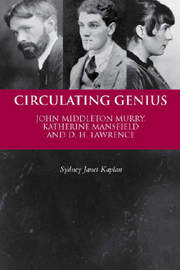Book contents
- Frontmatter
- Contents
- Acknowledgements
- Abbreviations
- Introduction
- 1 ‘My Blundering Way of Learning’: Murry's Still Life
- 2 Still Life and Women in Love
- 3 From Still Life to ‘Bliss’
- 4 ‘A Furious Bliss’
- 5 ‘With Cannonballs for Eyes’
- 6 ‘The Coming Man and Woman’
- 7 The Things We Are
- 8 Circulating Mansfield
- 9 Circulating Lawrence
- 10 Circulating Murry
- Bibliography
- Index
3 - From Still Life to ‘Bliss’
Published online by Cambridge University Press: 12 September 2012
- Frontmatter
- Contents
- Acknowledgements
- Abbreviations
- Introduction
- 1 ‘My Blundering Way of Learning’: Murry's Still Life
- 2 Still Life and Women in Love
- 3 From Still Life to ‘Bliss’
- 4 ‘A Furious Bliss’
- 5 ‘With Cannonballs for Eyes’
- 6 ‘The Coming Man and Woman’
- 7 The Things We Are
- 8 Circulating Mansfield
- 9 Circulating Lawrence
- 10 Circulating Murry
- Bibliography
- Index
Summary
The gradual shift from the influence of Lawrence to that of Bloomsbury marks a significant turning point in Murry's and Mansfield's positioning within British modernism. Their tentative, still awkward entry into the circle around Lady Ottoline Morrell at Garsington in the summer of 1916 would lead them in new directions, with profound consequences. It would not take long, however, for the same configurations of erotic desire and displaced sexual energy that lurked behind Murry's writing of Still Life to surface under the pressures of a new, if painfully familiar, triangular situation. This time Mansfield's jealousy would not be aroused by Murry's intimacy with another man – as it had been with Campbell and Lawrence – but another woman: Ottoline Morrell. It may well be that the events I describe in this chapter form the emotional background of one of Mansfield's most famous stories, ‘Bliss’ (1918). C. A. Hankin goes so far as to assert that ‘the germ’ of Mansfield's ‘central idea in “Bliss” … seems to have been her own and Murry's relationship with Ottoline Morrell’ (Hankin 1983: 142).
Beyond that ‘germ’, however, is the strong relationship between numerous elements of the story with Murry's Still Life. Its central character, Bertha Young, resembles Anne Cradock. Both are women around thirty, married, financially secure, their social lives centred in a world of fashionable people, artists and writers, up to date on the latest craze.
- Type
- Chapter
- Information
- Circulating GeniusJohn Middleton Murry Katherine Mansfield and D. H. Lawrence, pp. 57 - 71Publisher: Edinburgh University PressPrint publication year: 2010



